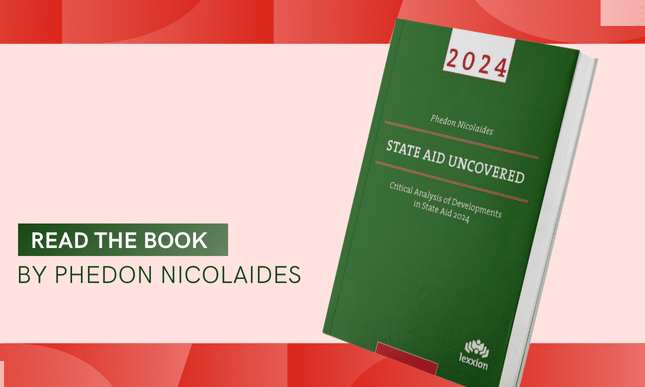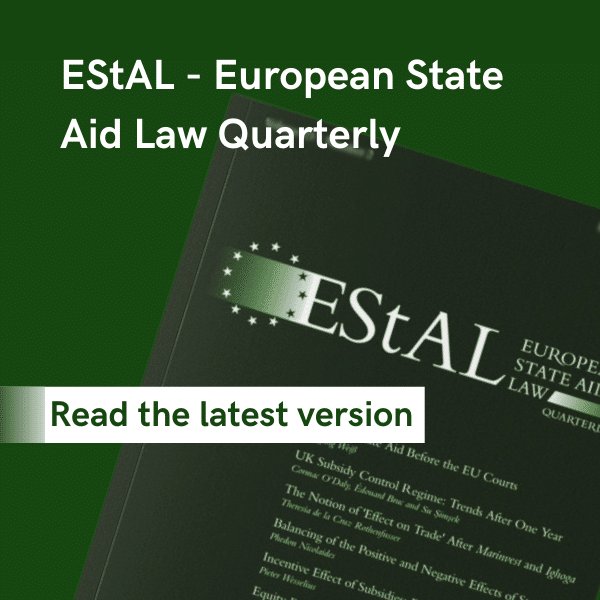
The Notice provides a thorough review of the case law and the decisional practice of the Commission.
Introduction
After more than two years of deliberations, the Commission Notice on the Notion of State Aid was published in the Official Journal on 19 July 2016.[1] The Notice presents “the Commission’s understanding of Article 107(1) of the Treaty, as interpreted by the Court of Justice and the General Court.” [3 (the numbers in brackets indicate the numbers of the corresponding paragraphs in the Notice)]
The main objective of the Notice is to contribute to a more consistent application of the concept of aid and “clarify the different constituent elements of the notion of State aid”. [5] The Notice also presents the Commission’s own views on how Article 107(1) should be applied to “issues that have not yet been considered by the Union Courts”. For these issues, “the Commission will set out how it considers that the notion of State aid should be construed.” [3]
The Notice is long, with numerous and detailed references to the relevant case law. It has a total number of 333 footnotes and extensive citation of case law. Just in this sense, it is an impressive document. It provides an excellent summary of the case law and identifies seminal cases.
The Notice extends to 50 pages and covers, in addition to the constituent elements of the concept of aid, the application of Article 107(1) to infrastructure. It also pays particular attention to tax measures in the section on selectivity.
The number of pages which are devoted to each topic is a rough indicator of both the complexity of the subject matter and the importance that the Commission attaches to it. The extent of the explanation and analysis of each topic in terms of number of pages is as follows:
- Notion of undertaking and economic activity [public powers, social security, health, education, culture]: 5
- State resources [origin & imputability]: 5
- Advantage: 12
Of which, market economy operator test: 9
- Selectivity [material & regional]: 13
Of which, tax measures: 6
- Effect on trade and competition: 4
- Infrastructure [owners, operators, users]: 5
On the basis of the crude indicator of page numbers, one could infer that the Commission perceives problems in the consistent application of the concept of aid in three areas: where public authorities act as market operators, in the design of tax measures and in the funding of infrastructure.
The final provisions of the Notice in section 8 state that it supersedes three previous communications concerning:
- Public undertakings in the manufacturing sector (1993),
- Sales of land and buildings by public authorities (1997),
- Direct business taxation (1998).
The Notice concludes with the statement that it “replaces any opposing statements relating to the notion of State aid included in any existing Commission Communications and Frameworks, save for statements pertaining to specific sectors and justified by their particular features.” [230]This means that the Notice is considered to be the definitive expression of the Commission’s position on what constitutes State aid. The only problem is that we are not told which the other statements are pertaining to specific sectors and why or how a different interpretation can be justified by their particular features.
The review of the Notice is divided in three parts. This week, Part I focuses on the concept of economic activity and state resources. Next week, Part II will examine the sections on advantage and selectivity. Part III will be published in the week after next and will cover the sections on trade and distortion of competition and infrastructure.
Concept of economic activity
After the introductory section that sets out the purpose of the Notice, section 2 deals with the concept of economic activity. It outlines the general principle that the decisive element in the designation of an entity as an undertaking is the nature of its activities which may change from time to time, not its legal status. A non-undertaking can become an undertaking even if its economic activities are a small subset of the totality of the activities it carries out. [7-11]
Do you know we also publish a journal on State aid?

The European State Aid Law Quarterly is available online and in print, and our subscribers benefit from a reduced price for our events.
Economic is any activity for which there is a market. [12] Although the market is not defined in the Notice, it covers voluntary transactions for which a “consideration” is paid that reflects the value of the good or service that is provided. The existence or not of a market depends on the political choices of Member States. A service that is provided by the market in one Member State may be completely based on non-market arrangements in another. A typical feature of non-market arrangements is compulsory, instead of voluntary, participation where any fee or price paid need not reflect the value of the service that is received [e.g. social insurance]. That is, the funding of the service is not borne or is only partly borne by the consumers of the service. Another typical feature of a non-market arrangement is demand which is based on rights or entitlements rather than purchasing ability [e.g. public health]. In other words, compulsion and entitlements do not correspond to the operations of markets.
Therefore, the Notice identifies the following activities which are traditionally considered to be non-economic:
- Exercise of exclusive state powers [17-18],
- Activities based on solidarity [e.g. social security, state pensions] [19-22],
- Activities for which individuals exercise their rights as citizens and are also based on solidarity [e.g. public health, public education] [23-42],
- Other activities which are intended for the general public and are funded by the state rather than the direct beneficiaries [e.g. cultural events and services] [33-37].
The inclusion of the last category in the Notice is particularly helpful because it clarifies that the payment of a small or token fee at a museum, for example, does not convert an otherwise non-economic activity into economic. The small fee hardly covers the costs of the museum. Also small shops in large hospitals are intended for the convenience of patients and their visitors, not because hospitals are branching out into the retail sector.
On the whole, this section is uncontroversial. In most instances it is clear when the state exercises its prerogatives and when a market exists. The problem arises when it comes to delineating closely linked economic and non-economic activities. The Notice uses terms such as “intrinsically form part of the prerogatives of official authority” [17] and “cannot be separated from the exercise of public powers”. [18] Recently, in several decisions concerning public funding of airports, the Commission concluded that firefighting facilities and services fell within the exercise of official powers [e.g. customs, air traffic control and security].[2] One wonders whether such facilities and services are “intrinsically” linked to or “cannot be separated” from official powers?
Later on in section 4 on advantage, the Notice states that undertakings obtain an advantage when they are relieved of costs which are “inherent” in their economic activities. [68] What is “inherent” is not only determined by available technology and economic strategies of undertakings, but also by the prevailing legislation. Since factories, large buildings and other private facilities have to have sufficient fire suppression equipment and fire evacuation procedures, it cannot be credibly argued that extinguishing a fire at a chemical factory is a private task while fighting a fire at an airport is a public task.
The last paragraph of the Notice stipulates that it prevails over conflicting interpretations in other notices and frameworks, but does not mention official Commission decisions. Will the Commission feel free in its formal decisions to deviate from the guidance in the Notice on the grounds that each case is assessed on its own merits? After all, the fact that the Commission is not bound by its own precedent has already been endorsed by EU courts.[3]
State resources
Section 3 of the Notice examines the conditions under which the funding of State aid is provided from states resources. It makes a distinction between the imputability of a measure to a decision of a public authority [39-46] and the use of resources which come under the control of the state. [47-65]
The Notice states that “a measure is not imputable to a Member State if the Member State is under an obligation to implement it under Union law without any discretion.” [44] It then goes on to assert that “this is not the case in situations where Union law simply allows for certain national measures and the Member State enjoys discretion (i) as to whether to adopt the measures in question or (ii) in establishing the characteristics of the concrete measure which are relevant from a State aid perspective.” [46]
The Commission is surely right that when the EU does not impose a measure on Member States but merely authorises Member States to act or, on application by Member States, the EU grants an exemption, then the measure must be attributed to the Member States.
With respect to the concept of state resources [47-65], the Notice explains at length that the concept covers also resources which are foregone by the state because, for example, land is sold below its market value or a loan is given at a rate of interest that falls below the market rate. Consequently, regulatory actions which do not result in any transfer (loss) of state resources fall outside the scope of Article 107(1).
But then the Notice proceeds to make a rather vague statement. “A transfer of State resources is present if, in a given case, the public authorities do not charge the normal amount under their general system for access to the public domain or natural resources, or for granting certain special or exclusive rights.” [55] What is not clear is what a “normal” amount is. Is it an amount that corresponds to a market rate? Or, is it an amount that covers the incremental costs of access plus reasonable profit, as in the case of users of airports and other infrastructure? Two paragraphs earlier, the Notice does refer to “market rates”. [53] Perhaps this statement should be understood as establishing a relative rather than an absolute standard. That is, state resources are forgone when access is priced at a rate which is lower than the rate charged to other users or the rate that is charged at other public domains. Selective treatment which is not objectively justified would indeed result in loss of state resources. In general, however, the authority responsible for the domain or the natural resources or for the management of the special or exclusive rights should behave as a market operator and charge a price that maximises revenue.
A particularly controversial issue between the Commission and Member States during the past few years has been the extent to which Member States can regulate financial transactions between undertakings without the sums involved being considered as state resources. Many Member States have put in place intricate arrangements whose purpose is to transfer funds from one group to another, usually from users of electricity to suppliers of green electricity. They have claimed that the procedures in place are objective and beyond their control. What matters in these situations is whether the state, first, makes such transfers mandatory and, second, whether the money transits through a channel which comes under the control of the state.
Certainly, Member States will continue their administrative and procedural innovations in an attempt to escape from the clutch of State aid law. However, the Notice observes that conferring private status to the entity that manages the transfers does not remove them from the ambit of Article 107(1) as long as the decisions of that private entity are dictated by the state. [64] The only reference to this point is a Commission decision on an Austrian measure in support of green electricity. More recently, however, the Commission used the same approach of examining whether an otherwise private entity was acting under the direction of the state in a decision concerning the management of the airport at the French city of Nîmes.[4]
The conclusion must be that the concept of state resources covers any arrangement that involves funds from sources going to destinations both of which are determined by the state and the funds pass through a channel that is controlled by the state.
Next week, we will look at sections 4 & 5 on advantage and selectivity.
———————————————————————-
[1] Its full title is Commission Notice on the notion of State aid as referred to in Article 107(1) of the Treaty on the Functioning of the European Union, OJ C262, 19/7/2016, p.1. The text of the Notice can be accessed at:
http://eur-lex.europa.eu/legal-content/EN/TXT/PDF/?uri=CELEX:52016XC0719(05)&from=EN.
[2] See, for example, Commission Decision 2015/1071 on State aid for Saarbruecken airport, OJ L179, 8/7/2015 and Commission Decision 2016/152 on State aid for Zweibruecken airport, OJ L34, 10/2/2016.
[3] See the judgment of the General Court of 12 May 2016 in case T-693/14, Hamr-Sport v Commission and the judgment of 9 June 2016 in case T-162/13, Magic Mountain Kletterhallen and others v Commission.
[4] See Commission Decision 2016/633 concerning aid granted to Nîmes airport, OJ, L113, 27/4/2016.



